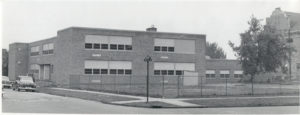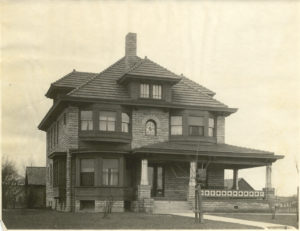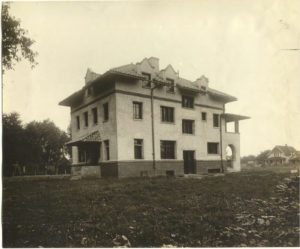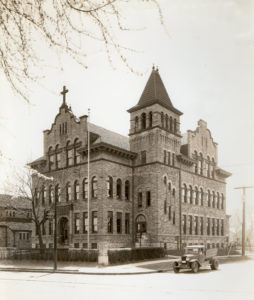St. Adalbert Parish
| Toledo Polish Churches > St. Adalbert Parish
St. Adalbert Parish: The Largest Parish in the Toledo Diocese A growing number of Polish immigrants into Lagrinka in the 1900s created a demand for a new ethnic parish. Bishop Ignatius Horstman of the Cleveland diocese chose Reverend Joseph Wachowski (born near Poznan in 1879) as the new pastor in October 1907. The parish was created by using Park Street, mid-way between the two churches, as the dividing line. The first church services were held in the old St. Hedwig church building on Dexter Street, beginning on February 23, 1908. The official announcement of the parish patron was made on March 15, 1908, as well as the election of the first councilmen: Constantine Kaminski, Stanislaus Sobecki, John Rybka and John Jesionowski. Father Wachowski bought 40 lots and a cottage (for the rectory) in the summer of 1908. The property was bounded by Lagrange, Warsaw, Oakland and Weber streets and cost $ 9,050. By November, enough money was raised to build a combination church/school building and a rectory. The cornerstone was laid by Bishop Joseph Koudelka on May 2, 1909. The building was a three-story structure with a basement, built of Sandusky limestone and sandstone trim, 70 feet by 100 feet. Two 90-foot towers were topped by red tile roofs. The first floor contained a chapel with seating for 800, hardwood floors, plastered walls, with the altar finished in white and gold. The second floor had six classrooms and a music room. The third floor had an auditorium with a capacity for almost one thousand. The basement had meeting rooms, play areas, washrooms and a boiler room. It was finished in October 1909. The ten-room rectory was built of the same materials and finished the previous month. The old rectory became the Sisters’ residence. Later this house was moved to its present location at 53 East Oakland Street. In 1915, a new convent was built for the Sisters in a Spanish style. The Felician Sisters order was founded in Warsaw, Poland in 1855, under the Third Order of St. Francis, their patron is Saint Felix. The Congregation of the Sister of St. Felix had been teaching at St. Adalbert School since 1909, until its closing. Sister M. Leonard was the first principal. There were 255 students registered in the first year; by 1913, there were 400. The first graduating class in 1914 consisted of three students: Anna Kordas, Anna Karpanty and Henry Czajkowski. The next year there were ten graduates. In October and November of 1918, school was closed because of the influenza epidemic. By 1920, enrollment was 705 students. Peak enrollment for St. Adalbert School was 1,056 students and twelve Sisters-teachers in the year 1924. Tuition was 60 cents per month. The church was dedicated on September 18, 1910, by Bishop Paul Rhode, at that time the first and only Polish bishop in the U.S. The rectory was damaged by fire in January 1925; damage was repaired and it was enlarged to its present size. The rapid growth of the Polish community on Lagrange Street soon dictated the need for a larger church building, and more classroom space for the overcrowded school. A new church was planned for the space between the church/school building and the rectory. The cornerstone was laid on April 19, 1927. The building was constructed of Massachusetts granite, 75 feet wide, 145 feet long with a 100-foot tower on one side, seating capacity of 1,500, and of the Spanish Mission style, costing $ 125,000. The altars, stations of the cross and the communion railing were in keeping with the Spanish Mission architecture. The bells and pipe organ from the old church were transferred into the new church. When St. Adalbert was first founded in 1907, there were about 150 families in the parish. By the time the second church was built, there were more than 1,000 families. St. Adalbert parish eventually became the largest parish in the diocese. The first Mass was celebrated on September 18, 1927 and dedicated by Bishop Samuel Stritch on April 22, 1928, which was also Father Wachowski’s silver jubilee as a priest. Shortly afterward, the Great Depression made it more difficult to pay off the debt from the new construction, but during Father Walter Czarnecki’s tenure as pastor (which began in 1937), the debt was paid off. Father Joseph Mrowca, the assistant pastor, arranged a festival on the parish grounds, proceeds were to be used toward raising $ 10,000 for decorating the interior of the church. Polish General Jozef Haller, who was famous in World War I and among other accomplishments, formed the Blue Army (uniform color) aka Haller’s Army, visited St. Adalbert School in May 1934. The study of the Polish language at the school was discontinued in 1935. Father Czarnecki decided the painting was to be done by a famous ecclesiastical artist, and it was completed by Christmas 1943. The paintings can still be seen adorning the walls of the church. Bishop George Rehring gave permission to Rev. Raymond Przybyla, administrator of the parish from 1956-57, to build a new school. Father Edward Zulka assumed the pastorate in 1957, and in 1960 a second floor was added to the school. The total cost of the new school was $ 459,000. Now the school could accommodate 950 students. The old school building served the parish from 1909 to 1961. Shortly after, the old church/school building was razed; currently the space is utilized by the parking lot. In the 1970s, under Father Joseph Mrowca’s tenure as pastor, new roofs were put on the church and school buildings, the interior of the church was repainted, a new organ was purchased, new windows were installed, a new lighting system was replaced, and the church tower was underpinned to prevent it from leaning over to one side. Pew rent was $ 7.50 per year, increasing to $ 10.00 then $ 15.00. When paid, the name of the father was inserted into the name holder above the hat slip on the back of the church pews. The Monday after graduation, all members of the class went to Walbridge Park for amusement rides and a picnic. The first Mass in English was in November 1964. In 2006, a year after the pontiff’s death, a ten-foot-tall bronze cast statue of John Paul II, the first Polish Pope, was placed in front of St. Adalbert church, surrounded by brick memorial pavers. The statue was designed and created, then cast in bronze by the Polish sculptor Michal Batkiewicz of Krakow. The statue weighs 2,100 pounds with another ton of concrete injected into the base for stability, and cost $ 30,000. It sits atop a granite base that looks like a globe. In 2005, the school was closed and meged with St. Hedwig School, becoming John Paul II School and located in the St. Adalbert school building. John Paul II School closed in June 2008. The St. Adalbert school building is currently being used by a charter school. St. Adalbert parish was twinned with St. Hedwig parish in 2005, and both were supressed (diocesan term for closed, all employees and organizations were terminated) in 2010, ending separate parish records. In 2010, the new Saints Adalbert and Hedwig parish was formed (now called “merged” by the diocese), and a new set of records was started; this new parish was also paired with St. Joseph in downtown Toledo. As of September 1, 2012, the St. Hedwig Church building was closed; no Masses are available there. Sacramental record books (aka metrical books) exist from 1908. Some of the earliest records can be seen online at the LDS database and website (www.familysearch.org), though they must be accessed by searching for Ohio – Diocese of Toledo records, then by parish; they are not on the LDS online index. The actual record books are stored at the diocesan archives in downtown Toledo. Pastors of St. Adalbert Parish: Reverend Joseph P. Wachowski (1907-1937) Reverend Walter J. Czarnecki (1937-1956) Reverend Raymond C. Przybyla, administrator (1956-1957) Reverend Edward A. Zulka (1957-1961) Reverend John Labuzinski (1961-1969) Reverend Joseph F. Mrowca (1969-1983) Reverend Albin A. Radecki (1983-1993) Reverend Gerald Grupczynski (1993-1998) Reverend Marek Ciesla (1998-2008) Reverend Richard Philiposki (2008-2010) Reverend Joseph Poggemeyer (2010-present) First Baptism: John Sobecki, son of Michael and Stanislawa (Szabatka) Sobecki, born March 8, 1908, baptized same day; godparents Joseph Sobecki and Constantia Szabatka, by Fr. Wachowski First Marriage: Joseph Wichowski and Mary Modzel, married on May 11, 1908 First Deaths: infant Frances Wyborska, age 9 months, died March 24, 1908, cause of death (infant) cholera First Holy Communion: May 1912, 110 boys and 94 girls; 104 men and 91 women Patron Saint: St. Adalbert of Prague, Wojciech (in Polish), Vojtech (in Czech), Bishop and Martyr, 956-997, feast day April 23 Vojtech was born in Libice nad Cidlinou, Bohemia (Czech Republic) in 956 to a noble Czech family, Prince Slavnik and his wife Strezislaca. He studied under St. Adalbert of Magdeburg and took his mentor’s name upon the elder’s death in 981. Adalbert became well-known all over Europe. He returned to Prague and became a priest. In 982, Adalbert became the Bishop of Prague at age 26, and was known for his charity. In 989, he resigned as bishop and went to Rome where he lived like a hermit in a Benedictine monastery. He was sent back to Bohemia to become a bishop again a few years later. He founded the first monastery in Czech lands in Brevnov. Adalbert went to Poland and became friends with Boleslaw I the Brave. The pope sent Adalbert to Prussia to convert the pagan Prussians living in (modern-day) northern Poland. The Prussians were a Slavic tribe which were later exterminated by the German Teutonic Knights; the Knights then took the name of this tribe and their lands for themselves, to this day the area being called Prussia. Boleslaw the Brave, duke (later king) of Poland, sent soldiers with Adalbert, and his followers also entered Prussia and went to Gdansk. Adalbert tried to chop down the sacred oak trees worshipped by the pagan Prussians to show them that the trees held no special powers. Warned by the Prussians to keep away from the oak groves, Adalbert did not, and was murdered in April 997 near Elblag on the Baltic Sea coast. Boleslaw the Brave ransomed Adalbert’s body for its weight in gold, and buried him at Gniezno, the first capitol of Poland. Adalbert was canonized in 999, and is called St. Adalbert of Prague. In 1039, according to Bohemian accounts, they stole Adalbert’s bones and transported them to Prague. According to Polish accounts, the Bohemian duke took the wrong relics (of St. Gaudensius) from Gniezno, and Adalbert’s relics remain in Gniezno. Years later, his decapitated head (not in the original purchase from the Prussians) was found and brought to Gniezno. In 1000, Boleslaw gave one of his arms to another monarch, and in 1928 it was finally reunited with the rest of his body. Both the cathedrals in Prague and Gniezno claim to contain Adalbert’s remains, including two skulls. St. Adalbert of Prague is the patron of Poland, Bohemia, Hungary and Prussia. He was the first patron saint of Poland, which officially accepted Christianity in the year 966 A.D. Prayer to St. Adalbert: O God, who bestowed the crown of martyrdom on the Bishop Saint Adalbert, as he burned with zeal for souls, grant, we pray, by his prayers, that the obedience of the flock may never fail the shepherds, nor the care of the shepherds be ever lacking to the flock. Through our Lord Jesus Christ, your Son, who lives and reigns with you in the unity of the Holy Spirit, one God, for ever and ever. Amen. Bibliography: www.catholic.org (St. Adalbert of Prague) www.litergies.net (St. Adalbert prayer) St. Adalbert Parish 75th Jubilee, 1907-1982, souvenir edition, Parafia Sw. Wojcieha St. Adalbert Church, 100th Anniversary of St. Adalbert Parish, 1907-2007. Booklet of photos and description of interior artwork (murals and statues) Clerus Toletanus: a Directory of Clergy, Religious Communities and Parishes of the Diocese of Toledo in America, 1910-2011, vol. 1 no. 1
|
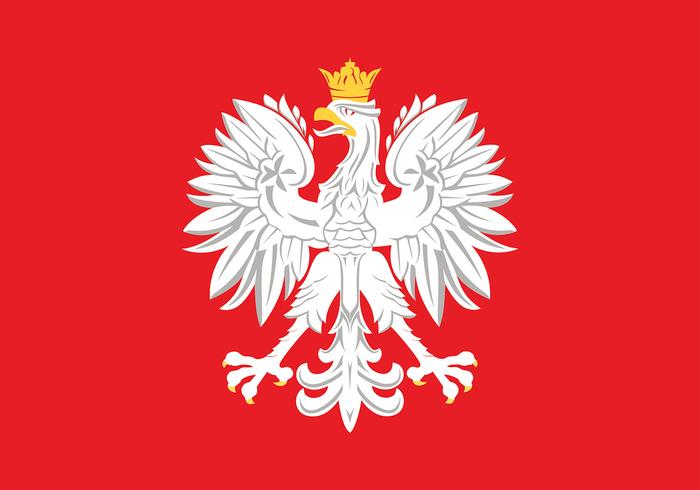
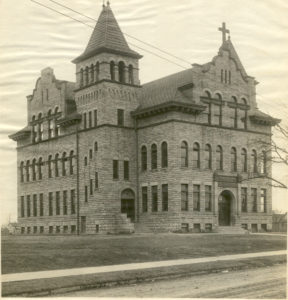
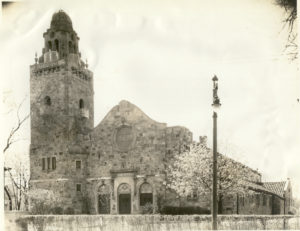
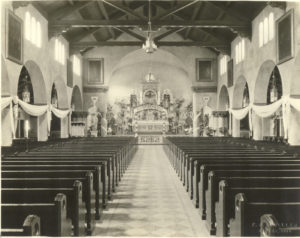 The dedication of the new St. Adalbert Church building was held on April 22, 1928, and coincided with Pastor Joseph Wachowski’s Silver Anniversary of his ordination. The interior of the church was decorated accordingly, including a banner over the altar proclaiming “tys kaplanem na wieki” (“you are a priest forever”).
The dedication of the new St. Adalbert Church building was held on April 22, 1928, and coincided with Pastor Joseph Wachowski’s Silver Anniversary of his ordination. The interior of the church was decorated accordingly, including a banner over the altar proclaiming “tys kaplanem na wieki” (“you are a priest forever”).